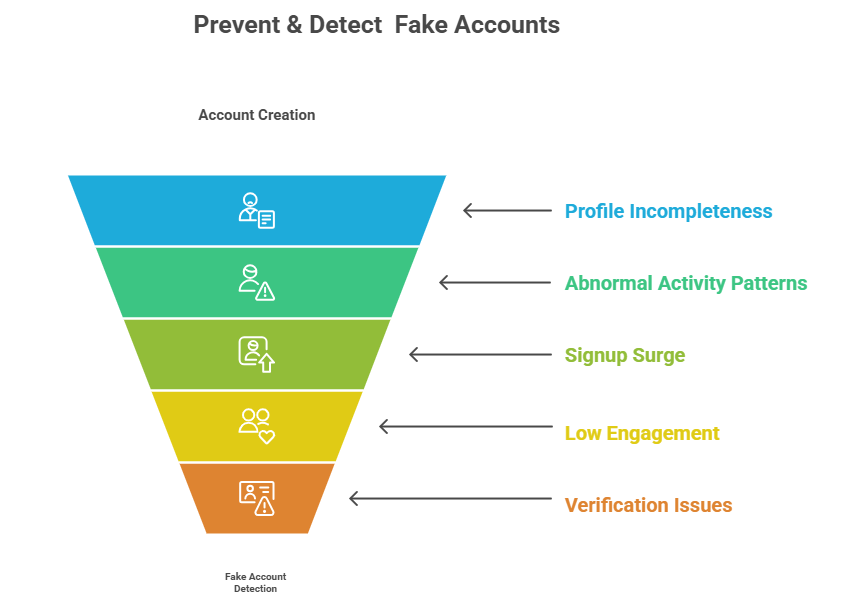As online businesses continuously refine their offerings and scale new markets, their security seems to be at risk more than ever. Fake accounts are a vulnerable loophole for businesses.
Advanced tools and software have evolved as effective aids for creating fake accounts on a large scale. Fake account creation can be costly for digital businesses and consumers alike. Understanding the risks, account creation mechanisms, impact, and defensive strategies makes you better equipped to combat the dilemma.
Whether you’re an individual or an online business, you’ll learn some amazing tips to protect yourself from cyber-attacks by the end of the blog. So, let’s get started!
Table of Contents
What is Fake Account Creation?
Fake account creation happens when the attacker creates an account by stealing information or fabricated information. These accounts use scripts or bots, thus creating a large number of them simultaneously. Once created, they perform different kinds of fraud and illegal acts.
People create fake accounts for:
- Malicious purposes: For sophisticated attacks like malware, phishing links, and spamming users.
- Spreading misinformation: Sharing fake comments and reviews, influencing public opinion with fake identities.
- Cyber harassment: People impersonate on social media to ridicule, embarrass or harass the person they pretend to be.
- Money laundering: Attackers can get your confidential information, ask for money or trick others into getting money.
- Free trial abuse: Users can create multiple accounts for free signups, special offers, or bonuses.
- Subscription abuse: Third-party websites can resell subscriptions at low prices without the consent of the original website.
- Review Fraud: People can add fake positive and negative reviews (for competitors), influencing public opinion.
How is a Fake Account Created?
Today, every online platform requires registration and account creation. To attract more users, platforms make the process easy and effortless. Fraudsters often exploit registration vulnerabilities.
Automated bots and scripts often use stolen information to create hundreds of accounts.
Such fake accounts can also be created manually. The bad actors gather data from different sources, such as stolen data, false information or both.
This process often involves bypassing the actual registration through APIs, making it easy to create multiple fake accounts.
Manual creation is often time-consuming and requires personnel. Alternatively, automated bots speed up the process but are more likely to be detected.
The most targeted industries are banking & finance, gaming, e-commerce, social media, and education.
How Does Fake Account Creation Affect Businesses?
Typically, one in five accounts are fraudulent in nature. Fake accounts can significantly affect both individuals and businesses. The extent of damage to businesses depends on the type of attack.
Some security and financial risks include:
Financial Losses
Fake accounts take advantage of promotions and discounts, leading to money loss. This money could have been spent on actual customers. Besides, organizations have to invest more in security tools for identifying and blocking fake accounts.
Misleading Analytics
Fake accounts can appear as actual customers on business data, which leads to skewed KPI metrics like active users, higher engagement, conversion rates, and session rates.
Spreading of Misinformation
Fake reviews, polls, or manipulated data can significantly influence public opinion. Some can even influence the organization to the extent that it disrupts its operations.
Wasted Marketing Spend
A whole lot of fake accounts means your marketing efforts are wasted on bots, scripts, and fraud farms, rather than actual users.
Brand Damage
Genuine customers wouldn’t risk joining platforms with a lot of fake accounts. This could impose a risk to their financial safety and security.
How to Detect & Prevent Fake Account Creation?
Detecting fake accounts requires research & anaysis. Earlier, detecting fake accounts was easier. With advanced technology and complex attacks, detection has become a challenge.
The basic goal is to identify unusual patterns in account creation & behaviour. Thus, you can easily distinguish the fake ones.

Look for These Fallouts
Incomplete profile information:
Bots typically create accounts with generic usernames like “queen123” or “abc123.” Also, fake accounts often lack specific details on interests, profile name, email id. The account newsfeed would be full of memes, GIFs, jokes and other irrelevant content.
Abnormal activity patterns:
Analyze patterns like low engagement, no or low interaction, or irregular posting frequency. Another common pattern is more actions in a limited time, which looks suspicious.
Unusual increase in signups:
Did your platform recently attract a lot of signups? Before you rejoice, pause. It could be a bot creating fake accounts en masse. So, verify the account details for genuine information.
Common Mistakes to Spot
Low followers or mutual contact:
A quick scroll through the follower and mutual contact list proves the account’s authenticity. This especially works for social media accounts.
Fake accounts have fewer followers and friends. And if you don’t recognize any friends, it’s better to avoid those requests.
No verified account badges:
Searching for celebrity social profiles? Fake accounts are the most prevalent problem. That said, the reliable blue verified badge has been an effective signpost.
Social media platforms like Twitter, LinkedIn, Facebook have a solid verification process in place.
Spelling mistakes or spaces
Spot a misplaced letter, an extra letter or a space in the username to identify a fake account. On the other hand, extra spaces implies bot-generated accounts.
Modern platforms use machine learning methods like labelled datasets, supervised, unsupervised learning and hybrid approach for bot account detection.
How to Prevent Fake Account Creation?
Preventing account creation is better than spotting fake accounts altogether. Isn’t it?
You can save your platform from potential financial implications, security risks, and brand damages by using multi-layered security.
As attackers employ advanced technology for security breaches, businesses and individuals need to ramp up security.
Captcha Challenges
Include Captcha challenges to distinguish automated bots from humans when they sign up. This could be a stumbling block for bots. And reduce speed when bots create a large number of accounts en masse.
Multi-Factor Authentication
Phone number verification, one-time passwords (OTP), push notifications, are few multi-factor authentication tools. These add an extra layer of security and reduce the risk of security breaches.
Analyze User Behaviour
Machine learning algorithms can detect unusual patterns in user behaviour. For example, unusual engagement with the website, click patterns, and browsing speed could imply fraud attempts.
Honeypot Fields
A highly effective preventive approach is honeypot fields. Now, these fields are invisible to actual users, but bots can mistake it as actual fields.
When they interact with honeypot fields, it triggers an alert and the signup process is blocked.
Limit Account Creation
Allow users to create a single account using the same email ID, device, domain, or phone number. This prevents account creation from fake identities or stolen information.
Strict Policies for Account Creation
Enforce policies like a valid email ID or phone number for account creation. Conduct regular audits to analyze vulnerabilities, enhance security measures, and ensure compliance.
Conclusion
In this digital age, data is more valuable than ever. Fraudsters and scammers are constantly looking to exploit vulnerabilities and launch security breaches. Fake accounts pose significant security and financial threat for individuals and businesses.
While you cannot completely stop fake account creation, employing adequate authentication and policy measures can reduce its intensity. We have covered everything you need to know about fake account creation above.
Choose a mix of preventive and mitigation strategies to reduce the negative impact. So, which of these strategies sounds like an actionable plan? Leave a comment below.
FAQs-Related to Fake Account Creation
1. What happens if you create a fake account?
Creating fake accounts can lead to legal penalties, account suspension, reporting, impersonation, etc. Everything depends on your platform rules and regulations. It can also damage your reputation and be counted as financial fraud.
2. How to avoid a fake profile?
To avoid a fake profile:
- Validate the profile details
- Review their account history & activity, including likes, comments, posts, etc
- Avoid clicking on suspicious links; this might include scams or phishing attacks
- Don’t share any personal information with such accounts
- Report such fake accounts if you find them suspicious.
3. Why do people create fake accounts?
People typically create fake accounts for reasons such as fraud, money laundering, defamation, or harassment.
4. How are fake accounts created?
Fake accounts can be created manually, by bots, or by using scripts. Automated account creation typically uses stolen or invalid information.


